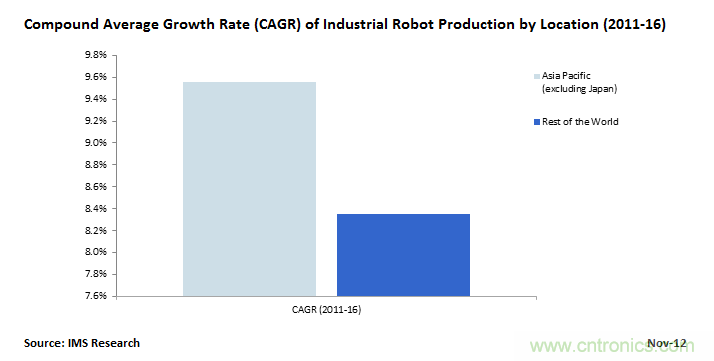【导读】工业生产正进入一个新的时代,即大规模的自动化生产取代人类手工劳动的时代,这种趋势在世界其他地方出现,但是最有可能在中国取得最大的发展,电子元件网推出IMS对此专业分析文章的中文版,以帮助大家了解。

工业机器人年复合增长率
2012年全球生产了二十万左右的工业机器人,生产这些机器人的厂家主要在欧洲和日本,这些地区已经具备建立起工业机器人生产的基础。在2011-2016年之间,机器人产品在亚太地区(包括日本)预计有9.6%的年复合增长率(CAGR),高于世界其他地区,中国对这个增长有显著贡献,而诸多影响因素可能使这个增长率增加的几率很大。
从那家供应商购买机器人取决于许多因素,类似于成本,应用,地点以及专业因素。某些情况下,政治因素也会有影响。比如,中国的终端用户反感同日本供应商进行生意往来,因为他们各自的政府在钓鱼岛问题上的争议,而大量应用于制造业基础投资的资金来自于中国政府控制的基金。
中国工业产品复合增长率比过去十年大概增加了14.5%,从而产生对于自动化的配套要求。在中国最近公布的第十二个五年计划中,明确表示:相对于严重依赖进口的方式,国家将会优先选择国内供应商提供的原料产品。本地制造商类似于GSK和SIASUN。尽管国内制造商尚需一段时间达到产品的可靠性要求,而主要的机器人生产商,ABB,KUKA和Yaskawa已经在该地区建立了生产基地。
可证实新闻是:中国工业机器人新闻是富士康宣布未来2-3年投入100万机器人到其工厂中,并且销售工业机器人。这个消息虽被质疑,但他们的确有投资自动化产业的需求,这来自于日益增长的关于富士康雇员的待遇和用工环境问题。且不论富士康是否能达成这个雄心勃勃的目标,在中国,对于工业机器人的关注增长是毋庸置疑的,随着中国社会人口结构变化,企业发现越来越难于发现廉价劳动力,因为很多年轻人相对于学徒型职业发展道路,更热衷于提高自己的教育水平。随着中国出现更多的本地机器人制造企业,更成熟的型号名称,可以清楚的看到,在未来十年中,中国机器人工业生产将会比世界上其他国家增长更快。
电子元件技术网翻译原创,原文请参考第二页
[page]
The Growth of China’s Industrial Robot Production
Kiran Patel
There were an estimated 200,000 industrial robots produced worldwide in 2012. The majority of the manufacturing of these robots took place in Europe and Japan, where there is already a base of established industrial robot producers. Between 2011 and 2016, the production of industrial robots in Asia Pacific (excluding Japan) is forecast to grow at a CAGR (compound average growth rate) of 9.6%, more than any other region in the world, with China set to contribute significantly to this growth. There are numerous influencing factors which may cause this CAGR to further increase by a large factor.
The decision to buy a robot from one vendor over another is dependent on many things such as cost, application, location and range of expertise. In certain circumstances, political alignment may also play a part. For example, Chinese end-users may be reluctant to do business with Japanese vendors due to the dispute between their respective governments over the Senkakus-Diaoyus islands - a significant amount of investment into manufacturing infrastructure relies on Chinese Government funding.
Chinese industrial production has increased at a CAGR of approximately 14.5% over the past decade, and the country’s demand for automation has followed suit. In its recently announced 12th five-year plan, it was clear that the country will seek to source goods from domestic suppliers rather than rely heavily on foreign imports. Local manufacturers such as GSK and SIASUN are two examples of domestic suppliers. However, it may take some time for domestic producers to establish credibility (even with a low cost solution), especially since major robot manufacturers such as ABB, KUKA Roboter and Yaskawa have opened up manufacturing facilities in the region.
Arguably the biggest news concerning the industrial robot market in China has been the announcement of Foxconn’s intention to deploy one million robots in its factories in the next 2-3 years, with intentions to sell onto the open market as well. This news has generally been met with scepticism. However, there is a definite need for the business to invest in automation, with growing concerns regarding the treatment and working conditions of its employees.
Whether or not Foxconn meet their ambitious production target, there is little doubt that the interest in industrial robots is growing in China. As the social demographic changes in China, businesses are finding it more and more difficult to find low-cost labourers as more young people are furthering their education rather than taking vocational apprenticeships. As more local robot manufacturers appear in China, alongside some of the more established names, it is clear that industrial robot production is set to increase more than in any other country in the world over the next decade.







